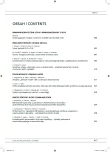Stabbing Penetrating Injuries of the Spinal Cord and Nerve Roots – Case Reports
Authors:
V. Přibáň 1,2; J. Fiedler 1; P. Řehoušek 1; M. Bombic 1
Authors‘ workplace:
Neurochirurgické oddělení, Nemocnice České Budějovice, a. s.
1; Neurochirurgická klinika LF MU a FN Brno
2
Published in:
Cesk Slov Neurol N 2010; 73/106(5): 559-562
Category:
Case Report
Overview
Injuries that penetrate the spinal cord and nerve roots are rare. No optimal therapy has yet been established. The authors present four case reports of injuries penetrating the spinal cord or nerve root, all of the patients victims of knife stabbings. Clinical symptoms: one case of complete transverse spinal cord lesion – paraplegia; one case of Brown-Séquard syndrome; one case of left L4–S1 nerve root lesion; and one case of asymptomatic clinical course after dorsal T1 nerve root transcision. Surgical therapy was based on wound revision, laminectomy, removal of foreign body if present and watertight closure of the dural sac. Antibiotics were administered during the peri-operative period. Relevant literature for the period 1950–2009 is summarized. Only eight case series and a few dozen case reports of penetrating spinal cord injuries are documented. A therapeutic protocol is suggested on the basis of our own experience and the review of the literature.
Key words:
spinal cord injuries – penetrating
Sources
1. Medical Research Council: Aids to the examination of the peripheral nervous system. Edinburgh: W. B. Saunders 2000.
2. Peacock WJ, Shrosbree RD, Key AG. A review of 450 stabwounds of the spinal cord. S Afr Med J 1977; 51(26): 961–964.
3. American Spinal Injury Association. International standards for neurological classification of spinal cord injury, revised 2000. 6th ed. Chicago (IL): American Spinal Injury Association 2000.
4. Lipschitz R, Block J. Stab wounds of the spinal cord. Lancet 1962; 2(7248): 169–172.
5. Velmahos GC, Degiannis E, Hart K, Souter I, Saadia R. Changing profiles in spinal cord injuries and risk factors influencing recovery after penetrating injuries. J Trauma 1995; 38(3): 334–337.
6. Simpson RK jr, Venger BH, Narayan RK. Treatment of acute penetrating injuries of the spine: a retrospective analysis. J Trauma 1989; 29(1): 42–46.
7. Thakur RC, Khosla VK, Kak VK. Non-missile penetrating injuries of the spine. Acta Neurochir (Wien) 1991; 113(3–4): 144–148.
8. Heary RF, Vaccaro AR, Mesa JJ, Balderston RA. Thoracolumbar infections in penetrating injuries to the spine. Orthop Clin North Am 1996; 27(1): 69–81.
9. Moyed S, Shanmuganathan K, Mirvis SE, Bethel A, Rothman M. MR paging of penetrating spinal trauma. AJR Am J Roentgenol 1999; 172(5): 1387–1391.
10. Ramaswamy R, Dow G, Bassi S. Pencil is mightier than the sword. Pediatr Neurosurg 2006; 42(3): 168–170.
11. Mouzopoulos G, Tzurbakis M. Unusual cervical spine injury by fishing harpoon. Eur J Emerg Med 2009; 16(5): 209–211.
12. Fransen P, Bourgeois S, Rommens J. Kirschner wire migration causing spinal cord injury one year after internal fixation of a clavicle fracture. Acta Orthop Belg 2007; 73(3): 390–392.
13. Přibáň V, Toufar P. Poranění míchy migrujícím Kirschnerovým drátem. Rozhl Chir 2005; 84(7): 373–375.
14. Russell JH, Joseph SJ, Snell BJ, Jithoo R. Brown-Sequard syndrome with Horner’s syndrome following a penetrating drill bit injury to the cervical spine. J Clin Neurosci 2009; 16(7): 975–977.
15. Groen RJ, Kafiluddin EA, Hamburger HL, Veldhuizen EJ. Spinal cord injury with a stingray spine. Acta neurochir (Wien) 2002; 144(5): 507–508.
16. Kryl J, Štulík J, Vyskočil T, Šebesta P. Poranění páteře nastřelovacím hřebem. Acta Chir Orthop Traumatol Czech 2006; 73(5): 353–355.
17. Roth EJ, Park T, Pang T, Yarkony GM, Lee MY. Traumatic cervical Brown-Sequard and Brown-Sequard plus syndromes: the spectrum of presentations and outcomes. Paraplegia 1991; 29(9): 582–589.
18. Brown-Séquard CÉ. De la transmission croisée des impressions sensitives par la moelle épinière. Comptes rendus de la Société de biologie 1851; 2: 33–44.
19. Beneš V. Poranění míchy. Praha: SZdN 1960.
20. Shahlaie K, Chang DJ, Anderson JT. Nonmissile penetrating spinal injury. Case report and review of the literature. J Neurosurg Spine 2006; 4(5): 400–408.
21. Kulkarni AV, Bhandari M, Stiver S, Reddy K. Delayed presentation of stab wound: case report and review of the literature. J Emerg Med 2000; 18(2): 209–213.
22. Karim NO, Nabors MW, Golocovsky M, Cooney FD. Spontaneous migration of a bullet in the spinal subarachnoid space causing delayed radicular symptoms. Neurosurgery 1986; 18(1): 97–100.
23. McFadden JR. Tissue reaction to standard neurosurgical metallic implants. J Neurosurg 1972; 36(5): 598–603.
24. Bracken MB, Shepard MJ, Collins WF, Holford TR, Young W, Baskin DS et al. A randomized, controlled trial of methylprednisolone or naloxone in the treatment of acute spinal-cord injury. Results of the Second National Acute Spinal Cord Injury Study. N Engl J Med 1990; 322(20): 1405–1411.
25. Levy ML, Gans W, Wijesinghe HS, SooHoo WE, Adkins RH, Stillerman CB. Use of methylprednisolone as an adjunct in the management of patients with penetrating spinal cord injury: Outcome analysis. Neurosurgery 1996; 39(6): 1141–1149.
Labels
Paediatric neurology Neurosurgery NeurologyArticle was published in
Czech and Slovak Neurology and Neurosurgery

2010 Issue 5
- Metamizole vs. Tramadol in Postoperative Analgesia
- Memantine in Dementia Therapy – Current Findings and Possible Future Applications
- Memantine Eases Daily Life for Patients and Caregivers
- Metamizole at a Glance and in Practice – Effective Non-Opioid Analgesic for All Ages
- Advances in the Treatment of Myasthenia Gravis on the Horizon
Most read in this issue
- Pudendal Neuralgia – a Case Report
- Development of the PLIF and TLIF Techniques
- Cubital Tunnel Syndrome – a Review of Surgical Treatments and Comparison of their Outcomes
- Gunshot Wounds of the Head and Brain
